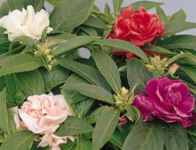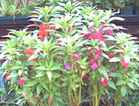BALSAM
HOW TO ORDER
(Impatiens
balsamina) is one of the varieties of plants that comprise Impatiens.
Members of the family Balsaminaceae, they are also known as Lady's
Slipper, Beijo de Frade, Fen Hsien, Hosen-ka, Ji Xing Zi, Kina
Cicegi, Snapweed, Spotted Snapweed, Pop Weed, Bang seed, or Touch me
Nots.
|
 |
Native to the subtropical
climates of Brazil, Haiti, Phillipines, Hawaii & China, these
tender annuals made their way to colder parts of the world and
appeared in many a Victorian garden. They differ from the standard
impatiens (Impatiens walleriana, a.k.a. Impatiens sultani) in both
growth habit and flower appearance. Garden balsam grows very tall on
a central stem, rather tham as a short bushy plant. Blooms of the
camellia flowered variety resemble tiny roses and the single flowered
types look more like large snapdragon blooms. Flowers have both male
and female organs and are easily pollinated by butterflies or bees,
which absolutely adore them.
A favorite because of
their fast growth and tall elegance, these stately beauties make a
wonderful back border for a flower bed or cottage garden or a
colorful edging for a pool. They can reach a height of 3ft. and a
stem girth of 1 inch, and the colors, ranging from white to pink,
purple into a deep burgundy red, are dramatic and create a tropical
air even in Minnesota. Newer hybrid types, such as Topknot, have
been bred for dwarf growth and maximum size bloom and placement.
We in the US have become
so accustomed to pre-packaged and fast food that details about the
nutritional and medicinal value of many plants has been forgotten.
One of the more interesting and lesser known facts about these plants
is that they are entirely edible - from leaf to stem. The leaves and
stems are often eaten cooked as a vegetable, tasting rather like
asparagus, and the seeds are collected and cooked as well. In many
countries the flowers are used as a cooling tonic and as a treatment
for burns and to make a tincture to use as an antibiotic. It is even
been said that the leaves can cure warts.
Touch me Nots are not
grown as often now as in the past and can be an unusual addition to
the modern annual garden. Plant them with standard or New Guinea
impatiens, with cosmos, or lobelia for contrast and color.
So, where did they get the
name Touch me Not? Try picking the seed pods when they are ripe and
you'll find out. It used to be a favorite game of mine as a kid to
seed if I could pick a seed pod before it exploded and the seeds flew
everywhere. Many of these 'seed bombs' wll spring into new plants
the following year
(Plant heights are given at maturity)
Back to VARIETY INDEX | HOME
Garden Balsam, Double Mixed (Touch-me-Not, Snapweed, Garden Balm, Ladys
Slipper)- Impatiens balsamina - Annual; Upright plants that bear camillia-like
double flowers from June to frost; this lovely heirloom gets its name from
the seed pods, which pop open at a touch. Repays even the harshest conditions
with a bright array of color. Heirloom; drought resistant, full sun or
partial shade; plant height 1-1/2 to 3ft.
 Garden
Balsam Single Mix
Garden
Balsam Single Mix
Garden Balsam, Single Mixed - Inpatiens balsamina - Annual; Identical
to above except flower are single. Heirloom, drought resistant, full sun
or partial shade; plant height 1-1/2 to 3ft.
 Topknot - Impatiens
balsamina - Annual; A different garden balsam, with tightly wound
double blooms at the top of the plant.
Topknot - Impatiens
balsamina - Annual; A different garden balsam, with tightly wound
double blooms at the top of the plant.
Full sun or partial shade; height: 14in.
BALSAM
The plants, like other
impatiens varieties, can be easily propagated by seed or cuttings
inserted into coarse sand. They do well in nearly any soil (even
heavy clay), but they really take off when planted in a mix of light
fibrous loam, peat moss, or leaf mold, and sand mixed with a liberal
amount of compost.
Seedlings can be started
from seed in a greenhouse where the temperature does not fall below
55F in a sterile medium in pots or trays. Keep the soil moist, but
not soggy and the temperature somewhere between 70 and 75F. When the
seedlings emerge, allow then to reach a height of 2-3 inches (which
they will achieve very quickly) before you transplant into larger
pots or outdoors. To start from cuttings, cut a small side branch at
the stem, or a section with leaves. Remove any blooms and the two
sets of leaves nearest the bottom of the cutting stem. You can dip
the stems into water, then coat the stem up over the bottom leaf
nodes in a rooting powder (or not, as you prefer) and simply insert
the cuttings into coarse sand. Keep the sand damp and syringe the
tops of the plants a couple of times each day to prevent excessive
drying. Allow plenty of air circulation to prevent the growth of
fungi that can damage the seedlings. Cuttings should root in about 14
days.
To transplant (whether
grown from seed or cutting) water the seedlings about thirty minutes
before and immediately after transplanting to avoid transplant shock.
Move the plants outdoors or transplant them outdoors in spring when
the soil has warmed to about 60F and the nighttime temperatures do
not fall below 55F. These plant are extremely sensitive to the cold,
so don't get too impatient. For the best flower production, keep one
center stem and pinch off any side stems that appear, or just let
nature take its course. Plant them in an area that has dappled shade
or morning or late afternoon sun for best results. They can take a
great deal of punishment, including some drought, but in Texas in
July, for example, they will probably need some irrigating. You will
have better success when planted in the garden than in containers.
ORDER EARLY!
See TERMS
Back to VARIETY INDEX Terms
HOME
 If
you have arrived in someone else's frame, or can not see all of the other
information available on richfarmgarden.com Click on logo to enter from
beginning
If
you have arrived in someone else's frame, or can not see all of the other
information available on richfarmgarden.com Click on logo to enter from
beginning
 Garden
Balsam Single Mix
Garden
Balsam Single Mix